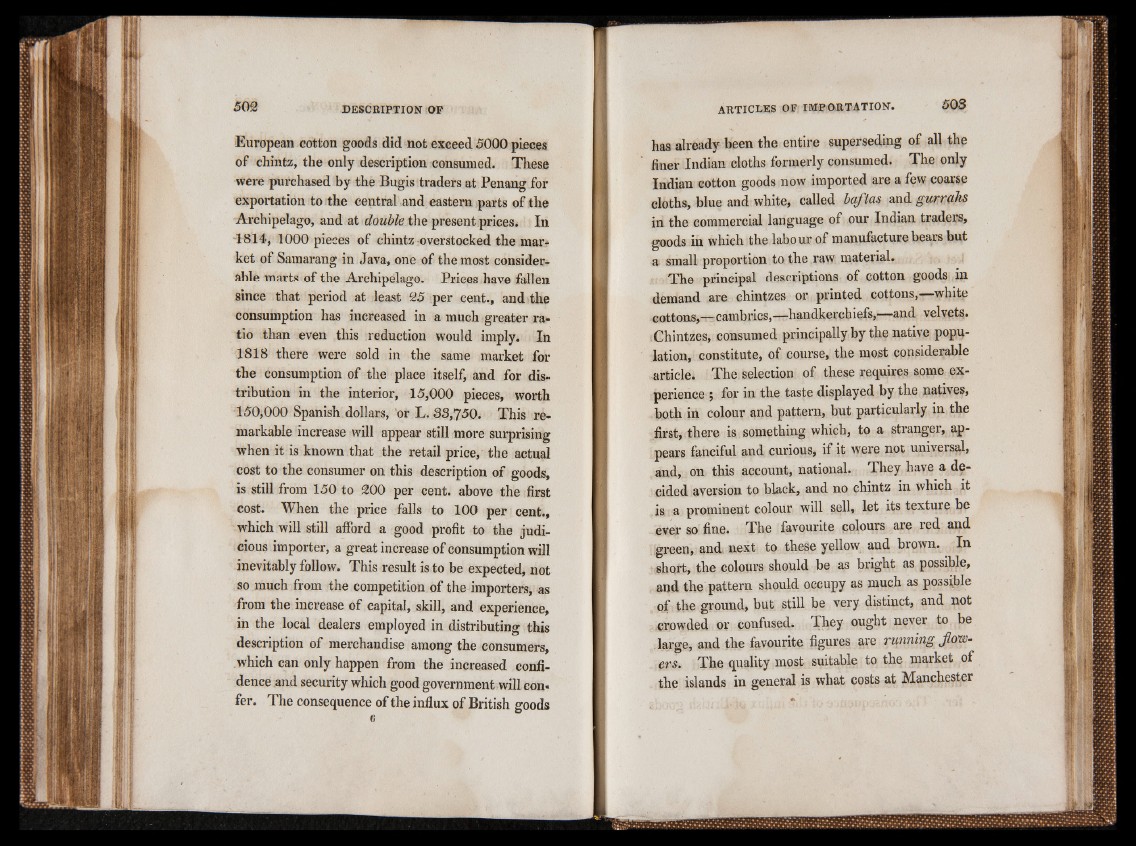
European cotton goods did not exceed 5000 pieces
of chintz, the only description consumed. These
were purchased by the Bugis traders at Penang for
exportation to the central and eastern parts of the
Archipelago, and at double the present prices. In
1814, 1000 pieces of chintz overstocked the market
of Samarang in Java, one of the most considerable
marts of the Archipelago. Prices have fallen
since that period at least 25 per cent., and the
consumption has increased in a much greater ratio
than even this reduction would imply. In
1818 there were sold in the same market for
the consumption of the place itself, and for distribution
in the interior, 15,000 pieces, worth
150,000 Spanish dollars, or L. 38,750. This remarkable
increase will appear still more surprising
when it is known that the retail price, the actual
cost to the consumer on this description of goods,
is still from 150 to 200 per cent, above the first
cost. When the price falls to 100 per cent.,
which will still afford a good profit to the judicious
importer, a great increase of consumption will
inevitably follow. This result is to be expected, not
so much from the competition of the importers, as
from the increase of capital, skill, and experience,
in the local dealers employed in distributing this
description of merchandise among the consumers,
which can only happen from the increased confidence
and security which good government will con«
fer. The consequence of the influx of British goods
6
has already been the entire superseding of all the
finer Indian cloths formerly consumed. The only
Indian cotton goods now imported are a few coarse
cloths, blue and white, called baflas and gurrahs
in the commercial language of our Indian traders,
goods in which the labour of manufacture bears but
a small proportion to the raw material.
The principal descriptions of cotton goods in
demand are chintzes or printed cottons,—white
cottons,—cambrics,—handkerchiefs,—and velvets.
Chintzes, consumed principally by the native population,
constitute, of course, the most considerable
article. The selection of these requires some experience
; for in the taste displayed by the natives,
both in colour and pattern, but particularly in the
first, there is something which, to a stranger, appears
fanciful and curious, if it were not universal,
and, on this account, national. They have a decided
aversion to black, and no chintz in which it
is a prominent colour will sell, let its texture be
ever so fine. The favourite colours are red and
green, and next to these yellow and brown. In
short, the colours should be as bright as possible,
and the pattern should occupy as much as possible
of the ground, but still be very distinct, and not
crowded or confused. They ought never to be
. large, and the favourite figures are running Jlow-
erS' The quality most suitable to the market of
the islands in general is what costs at Manchester